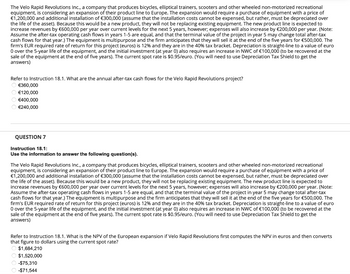
Essentials Of Investments
11th Edition
ISBN: 9781260013924
Author: Bodie, Zvi, Kane, Alex, MARCUS, Alan J.
Publisher: Mcgraw-hill Education,
expand_more
expand_more
format_list_bulleted
Concept explainers
Topic Video
Question
thumb_up100%
Please try to both questions i will give you upvot

Transcribed Image Text:The Velo Rapid Revolutions Inc., a company that produces bicycles, elliptical trainers, scooters and other wheeled non-motorized recreational
equipment, is considering an expansion of their product line to Europe. The expansion would require a purchase of equipment with a price of
€1,200,000 and additional installation of €300,000 (assume that the installation costs cannot be expensed, but rather, must be depreciated over
the life of the asset). Because this would be a a new product, they will not be replacing existing equipment. The new product line is expected to
increase revenues by €600,000 per year over current levels for the next 5 years, however; expenses will also increase by €200,000 per year. (Note:
Assume the after-tax operating cash flows in years 1-5 are equal, and that the terminal value of the project in year 5 may change total after-tax
cash flows for that year.) The equipment is multipurpose and the firm anticipates that they will sell it at the end of the five years for €500,000. The
firm's EUR required rate of return for this project (euros) is 12% and they are in the 40% tax bracket. Depreciation is straight-line to a value of euro
O over the 5-year life of the equipment, and the initial investment (at year 0) also requires an increase in NWC of €100,000 (to be recovered at the
sale of the equipment at the end of five years). The current spot rate is $0.95/euro. (You will need to use Depreciation Tax Shield to get the
answers)
Refer to Instruction 18.1. What are the annual after-tax cash flows for the Velo Rapid Revolutions project?
€360,000
Ⓒ €120,000
€400,000
€240,000
QUESTION 7
Instruction 18.1:
Use the information to answer the following question(s).
The Velo Rapid Revolutions Inc., a company that produces bicycles, elliptical trainers, scooters and other wheeled non-motorized recreational
equipment, is considering an expansion of their product line to Europe. The expansion would require a purchase of equipment with a price of
€1,200,000 and additional installation of €300,000 (assume that the installation costs cannot be expensed, but rather, must be depreciated
the life of the asset). Because this would be a new product, they will not be replacing existing equipment. The new product line is expected to
increase revenues by €600,000 per year over current levels for the next 5 years, however; expenses will also increase by €200,000 per year. (Note:
Assume the after-tax operating cash flows in years 1-5 are equal, and that the terminal value of the project in year 5 may change total after-tax
cash flows for that year.) The equipment is multipurpose and the firm anticipates that they will sell it at the end of the five years for €500,000. The
firm's EUR required rate of return for this project (euros) is 12% and they are in the 40% tax bracket. Depreciation is straight-line to a value of euro
O over the 5-year life of the equipment, and the initial investment (at year 0) also requires an increase in NWC of €100,000 (to be recovered at the
sale of the equipment at the end of five years). The current spot rate is $0.95/euro. (You will need to use Depreciation Tax Shield to get the
answers)
over
Refer to Instruction 18.1. What is the NPV of the European expansion if Velo Rapid Revolutions first computes the NPV in euros and then converts
that figure to dollars using the current spot rate?
$1,684,210
$1,520,000
-$75,310
-$71,544
Expert Solution
This question has been solved!
Explore an expertly crafted, step-by-step solution for a thorough understanding of key concepts.
This is a popular solution
Trending nowThis is a popular solution!
Step by stepSolved in 3 steps with 4 images

Knowledge Booster
Learn more about
Need a deep-dive on the concept behind this application? Look no further. Learn more about this topic, finance and related others by exploring similar questions and additional content below.Similar questions
- can you explain why the answer for the third part is option number 2 from the selection of answersarrow_forwardI need to know how to find FIFOarrow_forwardwhat exactly is a cookie jar reserve? Does using a cookie jar reserve follow GAAP? Does using a cookie jar reserve appear to be an ethical practice? Support your opinion. Your post should be more than a single sentence.arrow_forward
arrow_back_ios
arrow_forward_ios
Recommended textbooks for you
 Essentials Of InvestmentsFinanceISBN:9781260013924Author:Bodie, Zvi, Kane, Alex, MARCUS, Alan J.Publisher:Mcgraw-hill Education,
Essentials Of InvestmentsFinanceISBN:9781260013924Author:Bodie, Zvi, Kane, Alex, MARCUS, Alan J.Publisher:Mcgraw-hill Education,

 Foundations Of FinanceFinanceISBN:9780134897264Author:KEOWN, Arthur J., Martin, John D., PETTY, J. WilliamPublisher:Pearson,
Foundations Of FinanceFinanceISBN:9780134897264Author:KEOWN, Arthur J., Martin, John D., PETTY, J. WilliamPublisher:Pearson, Fundamentals of Financial Management (MindTap Cou...FinanceISBN:9781337395250Author:Eugene F. Brigham, Joel F. HoustonPublisher:Cengage Learning
Fundamentals of Financial Management (MindTap Cou...FinanceISBN:9781337395250Author:Eugene F. Brigham, Joel F. HoustonPublisher:Cengage Learning Corporate Finance (The Mcgraw-hill/Irwin Series i...FinanceISBN:9780077861759Author:Stephen A. Ross Franco Modigliani Professor of Financial Economics Professor, Randolph W Westerfield Robert R. Dockson Deans Chair in Bus. Admin., Jeffrey Jaffe, Bradford D Jordan ProfessorPublisher:McGraw-Hill Education
Corporate Finance (The Mcgraw-hill/Irwin Series i...FinanceISBN:9780077861759Author:Stephen A. Ross Franco Modigliani Professor of Financial Economics Professor, Randolph W Westerfield Robert R. Dockson Deans Chair in Bus. Admin., Jeffrey Jaffe, Bradford D Jordan ProfessorPublisher:McGraw-Hill Education

Essentials Of Investments
Finance
ISBN:9781260013924
Author:Bodie, Zvi, Kane, Alex, MARCUS, Alan J.
Publisher:Mcgraw-hill Education,



Foundations Of Finance
Finance
ISBN:9780134897264
Author:KEOWN, Arthur J., Martin, John D., PETTY, J. William
Publisher:Pearson,

Fundamentals of Financial Management (MindTap Cou...
Finance
ISBN:9781337395250
Author:Eugene F. Brigham, Joel F. Houston
Publisher:Cengage Learning

Corporate Finance (The Mcgraw-hill/Irwin Series i...
Finance
ISBN:9780077861759
Author:Stephen A. Ross Franco Modigliani Professor of Financial Economics Professor, Randolph W Westerfield Robert R. Dockson Deans Chair in Bus. Admin., Jeffrey Jaffe, Bradford D Jordan Professor
Publisher:McGraw-Hill Education